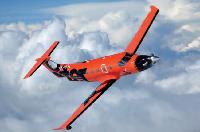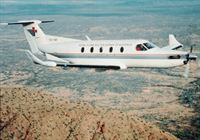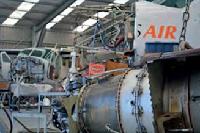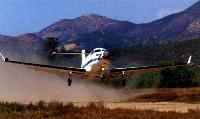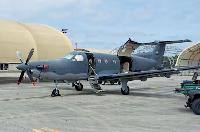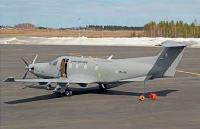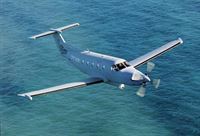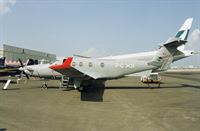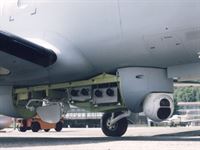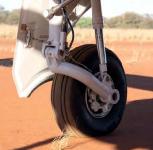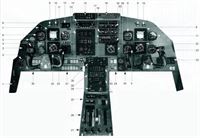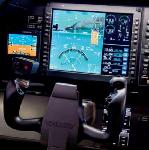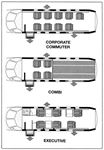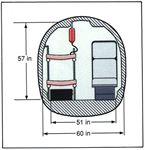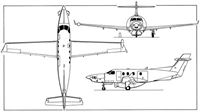
Описание
Страна : Швейцария
Год : 1991
Корпоративный и пассажирский самолет вместимостью 6-8 или 9 пассажиров, соответственно
Pilatus PC-12
PC-12 стал вторым корпоративным самолетом, оснащенным одним турбовинтовым двигателем (первым был Piper Malibu, а третьим стал SOCATA TBM 850). Прототип был облетан 31 мая 1991 года, а вторая машина поднялась в воздух 28 мая 1993 года. Сертификат типа Федеральная авиационная администрация США выдала самолету в июле 1994 года, а первый заказчик получил самолет в сентябре 1994 года. Конструктивно PC-12 представлял собой моноплан с низкорасположенным трапециевидным крылом с Т-образным хвостовым оперением. Планер самолета выполнялся преимущественно из алюминиевых сплавов, а в конструкции подфюзеляжных гребней и форкиля были применены композиционные материалы.
Первой самолет в эксплуатацию поставила канадская компания "Kelner Airways", получившая первую машину в 1997 году. Кроме поставок гражданским заказчикам, самолет поступил на вооружение в ряде стран мира. Наиболее крупным заказчиком стали ВВС США - они приобрели 36 самолетов, которым было присвоено обозначение U-28. Часть из них привлекаются для обеспечения действий Сил специальных операций.
ТАКТИКО-ТЕХНИЧЕСКИЕ ХАРАКТЕРИСТИКИ
Pilatus PC-12
Тип: корпоративный и пассажирский самолет вместимостью 6-8 или 9 пассажиров, соответственно
Силовая установка: один ТВД Pratt & Whitney Canada PT6A-67B мощностью 1605 л. с. (1197 кВт)
Летные характеристики: максимальная скорость 444 км/ч; максимальная дальность полета с резервом топлива по правилам VFR - 4187 км
Масса: пустого 2600 кг; максимальная взлетная 4500 кг
Размеры: размах крыла 16,23 м; длина 14,40 м; высота 4,27 м; площадь крыла 25,81 м2
Полезная нагрузка: 1410 кг (один пилот); в комбинированном варианте 1474 кг
- Описание
Фотографии
-
Мировая Авиация 158
Регистрационный номер: HB-FOO Другой самолет, Pilatus PC-12 (на фото), имеет лишь один двигатель, но может перевозить до девяти пассажиров или же шесть человек при комфортабельной конфигурации салона.
-
Air International 2015-07 / D.Unwin - A Class of its Own /Commercial/
Регистрационный номер: N1130D -
Air International 2015-07 / D.Unwin - A Class of its Own /Commercial/
Регистрационный номер: OY-PLB Dexter Air Taxi uses a fleet of PC-12s for flights in Russia.
-
Air International 2022-09 / M.Broadbent - State of emergency
Регистрационный номер: C-GRXE The Pilatus PC-12 is a workhorse of air ambulance operations worldwide, as with this example seen over Lake Superior
-
Air Pictorial 1999-10 / B.Wheeler - PC-12: A Swiss sophisticate
Регистрационный номер: ZS-BEL, ZS-NYM Africa has proved a buoyant market for the PC-12 with some 25 in use, including ZS-BEL, flying with General Airways, and ’NYM of the Red Cross Mercy Air Service Trust.
-
Jane's All the World Aircraft 2000 / 2-01 - AIRCRAFT - FIXED-WING - CIVIL
Регистрационный номер: VH-FMF Pilatus PC-12 of the Australian Royal Flying Doctor Service (1999)
-
Air International 2015-07 / D.Unwin - A Class of its Own /Commercial/
Регистрационный номер: VH-FVD The PC-12’s rugged construction makes the aircraft ideal for Australia's Royal Flying Doctor Service, which operates over 30 examples.
-
Air International 2022-10 / C.West - Small but perfectly formed
Регистрационный номер: VH-FXZ Australia’s Royal Flying Doctor Service was the launch customer for the Pilatus PC-12, receiving its maiden example in 1994
-
Air International 2023-04 / M.Broadbent - Care in the air
Turboprops, including this Royal Flying Doctor Service PC-12 in Australia, can reach remote locations it would be difficult or impossible to serve with either ground transport or helicopters
-
Air International 2025-03 / A.Preston - On a mission: Flying Doctors
Remote communities rely on the crucial healthcare services offered by flying doctors for emergency and primary healthcare services alike
-
Air International 2022-09 / M.Broadbent - State of emergency
Royal Flying Doctor Service PC-12s are often called to isolated locations in the Australian outback
-
Air International 2023-04 / M.Broadbent - Care in the air
Australia’s Royal Flying Doctor Service collects a patient under cover of darkness
-
Air International 2020-01 / Focus: Rotary, Business, Technology
The new Pilatus PC-12 NGX aircraft is powered by the PT6E-67XP engine.
-
Мировая Авиация 237
Регистрационный номер: N593PC Pilatus PC-12 Авиации Управления авиационных и морских сил
-
Air International 2015-04 / News
Surf Air is providing executive travel to its members between West Coast US cities.
-
Air International 2018-03 / C.Kjelgaard - Sounds Interesting /Commercial/
Регистрационный номер: ZK-PLT PC-12/45 ZK-PLT is one of five in Sound Air's fleet.
-
Air International 2018-03 / C.Kjelgaard - Sounds Interesting /Commercial/
The Sounds Air fleet at Picton aerodrome, the airline's home base.
Другие самолёты на фотографии: Cessna 208 Caravan / U-27 - США - 1982
-
Air International 2018-03 / C.Kjelgaard - Sounds Interesting /Commercial/
A Pratt & Whitney Canada PT6A engine off wing during maintenance.
-
Мировая Авиация 214
Регистрационный номер: HB-FOT После первых же полетов на PC-12 было решено установить законцовки крыла, винглеты. На фотографии - прототип модификации PC-12/45 High Gross Weight.
-
Мировая Авиация 214
Благодаря опыту, полученному по проекту PC-6, взлетно-посадочные характеристики PC-12 оказались просто превосходными.
-
Air International 2008-02 / News: Headline, Military, Civil, Accidents
Регистрационный номер: N131JN Pilatus PC-12/45 N131JN (c/n 446) arrives at Cannon Air Force Base, New Mexico, on January 8, 2008 for the 318th Special Operations Squadron (SOS), which is due to formally activate in March as part of the 27th Special Operations Wing (SOW).
-
Air International 2022-10 / C.West - Small but perfectly formed
Since May 2016, Okavango Air Rescue has relied on a single PC-12 for its operations in Botswana and across southern Africa
-
Air International 2015-07 / D.Unwin - A Class of its Own /Commercial/
The PC-12 can take nine passengers over 1,800 nautical miles from short, unprepared runways.
-
Air International 2014-02 / J.Dorschner - Hungary's Fleet Revolution /Military/
A Hungarian tender for second hand transport aircraft was released on June 7, 2013. Given the limited funds available, one viable option is the Pilatus PC-12.
-
Air International 2015-07 / D.Unwin - A Class of its Own /Commercial/
Регистрационный номер: HB-FVI PC-12 HB-FVI is used by the Sauber Formula One team to fly drivers around Europe. The aircraft is seen here in 2012, when it was delivered, and is painted to represent the team’s car that year.
-
Air International 2016-05 / Airscene
Регистрационный номер: N327SF Owned by the State of Colorado, and operated by their Department of Public Safety, Pilatus PC-12 N327SF (c/n 511) has been fitted with Sierra Nevada Corporation's Wildland Fire Management System. Using electro-optical and infrared systems with geospatial processing, this multi-mission aircraft goes from the early detection and mapping of wildfires to safety overwatch of communities and firefighters. With the high performance and long range of the PC-12 it also provides command and control of the air attack forces being employed to fight the fire that includes evaluation of the effectiveness of the retardant drops.
-
Air International 2012-11 / News
Регистрационный номер: A2-MDM Noted visiting Lanseria Airport in South Africa on September 20, 2012 was Pilatus PC-12/47E JK-1 (c/n 1105, ex A2-MDM) of the Botswana Defence Force Air Wing. Two examples of the turboprop were acquired second-hand in mid-2012.
-
Air International 2022-08 / P.Eden - Connection
Data from the Pratt & Whitney Canada PT6E-67XP turboprop powering the Pilatus PC-12NGX is gathered during flight and downloaded to the engine manufacturer upon landing
-
Air Pictorial 1999-10 / B.Wheeler - PC-12: A Swiss sophisticate
Регистрационный номер: HB-FOE Easy access to the cabin for passengers and to the engine for maintenance was an early design goal. The large rear freight door, in particular, has appealed to medical operators.
-
Air International 2022-10 / C.West - Small but perfectly formed
Регистрационный номер: N1677 The Pilatus PC-12 was originally designed for shortfield operations and unpaved runways, despite its popularity among the business aviation community
-
Air Pictorial 1999-10 / B.Wheeler - PC-12: A Swiss sophisticate
Регистрационный номер: N312PC -
Air International 2011-12 / M.Jerram - BizJet Showcase
Регистрационный номер: N265NX Five aircraft, including Pilatus PC-12 N265NX, were displayed in the exhibition halls.
-
Air International 2015-04 / News
Регистрационный номер: N819SA N819SA is Surf Air’s fourth PC-12 and one of 15 ordered by the Santa Monica-based company, which also has options on 50 others.
-
Air International 2021-05 / M.Legnani - Hybrids in Hawaii
Surf Air Mobility aims to bring more affordable, sustainable and personalised air transport to everyone, beginning with regional travel
-
Air International 2013-10 / News
Two Pilatus U-28As of the 319th Special Operations Squadron, 1st Special Operations Wing, are deployed to Stuttgart Airport in Germany to support US African Command. U-28A 07-0793 (c/n 793) was noted operating from the airport on August 12.
-
Air International 2021-04 / S.Rivas - Cracking the drug cartels
A pair of Pilatus PC-12s of Argentina’s Gendarmeria Nacional crime-fighting force. The aircraft's speed is crucial for operations in such a vast country.
-
Air International 2021-04 / S.Rivas - Cracking the drug cartels
Part of the Gendarmeria fleet seen in front of their hangar at Campo de Mayo Airfield, where the AW169, the two Turbo Porters, the EC135, two Ecureuils and one PC-12 can be seen. The force currently operates a small but efficient fleet to operate in difficult areas where there is not much infrastructure
Другие самолёты на фотографии: Aerospatiale Ecureuil / SA.350 - Франция - 1974Agusta Westland AW.169 - International - 2012Eurocopter EC.135 - International - 1994Pilatus PC-6 Porter / Turbo Porter - Швейцария - 1959
-
Air International 2017-12 / C.Kjelgaard - Tailwinds for Tradewind /Commercial/
Регистрационный номер: N524TW, N590TW -
Air International 2020-11 / News: Commercial, Military
Регистрационный номер: N280NG, N281NG, N282NG Three new Irish Air Corps PC-12NG Spectres on the ramp at Baldonnel, County Dublin, on September 16, 2020 during a welcoming ceremony by Irish Minister for Defence and Minister for Foreign Affairs Simon Coveney.
-
Air International 2014-11 / D.Isby - The Future of Liberty /Military/
In its FY2015 budget proposal, the US Air Force plans to transfer 33 MC-12Ws to US Special Operations Command to replace the Pilatus-built U-28A.
-
Air International 2006-09 / News: Headline, Military, Civil, Airshow
USAF/319th SOS Pilatus U-28A 05-0482 departs from Lajes/Terceira Airport in the Azores on July 9, 2006 en route to the US Central Command theatre of operations, with Afghanistan or Iraq its most likely final destination.
-
Air International 2019-11 / M.Ayton - School days /Military/
This toned-down camouflage laden PC-12 turboprop is not used to fly business executives around and about. This is a U-28A operated by Air Force Special Operations Command. Two U-28As were present at Nellis during Class 19A WSINT flying missions from the super base to desert strips in the Nevada Test and Training Range.
-
Air International 2017-04 / R.Niccoli - Special Ops /Military/
Two squadrons operate the U-28A, for utility and ISR missions.
-
Air International 2017-08 / M.Vallianos - Arctic Challenge /Military/
Finland's Ilmavoimat deployed one C295M and a single PC-12 to Rovaniemi for the duration of Arctic Challenge. Assigned to the TukiLLv based at Tampere-Pirkkala, both aircraft flew daily missions.
-
Air International 2022-03 / S.Gourley - High Society
A forward area refuelling point airman assigned to the 27th Special Operations Mission Sustainment Team 1 provides perimeter security near a U-28 Draco during operational readiness exercises in 2021
-
Air International 2017-08 / M.Vallianos - Arctic Challenge /Military/
Регистрационный номер: PI-06 The crew of this Ilmavoimat PC-12/47E PI-06 refuel the aircraft at Rovaniemi.
-
Air International 2022-08 / J.Campion - Ireland's Ambitions
The most recent entry into IAC service is the Pilatus PC-12 Spectre. Three PC-12s are utilised by Ireland for ISR operations. The PC-12 could potentially be the first-ever IAC aircraft to deploy overseas, with talks ongoing regarding a UN deployment later this year
-
Air International 2024-06 / A.Dron - Standing alone
Ireland operates four PC-12s. The three PC-12NG Spectres were delivered to the IAC in September 2020 as replacements for the air arm's fleet of ageing Reims Rocket FR172H aircraft. A fourth, non-modified PC-12 was acquired by the Irish government to address a shortfall in the nation's airlift capabilities
-
Air International 2024-06 / A.Dron - Standing alone
An aircrew member from No 104 Squadron leaves a PC-12NG Spectre after completing an ISR training flight. The type has fully established itself as a vital asset in Irish military operations
-
Air International 2022-04 / C.Croot - Aeromed evac
The IAC's Learjet 45 sits in the hangar awaiting its next tasking, with two Pilatus PC-12s in the background
Другие самолёты на фотографии: Learjet Learjet 31 / 45 / 40 / 75 / 85 - США - 1987
-
Air International 2015-02 / News
Регистрационный номер: HB-FWA Pilatus marked its 75th anniversary by painting a new demonstrator PC-12NG HB-FWA (c/n 1515) in a striking scheme designed by a 105-year-old Swiss artist, Hans Erni, depicting Pegasus, the mythical winged horse.
-
Air International 2020-03 / Conferences and Events
Регистрационный номер: HB-FXR European Business Aviation Convention and Exhibition 2019 visitors gather around Pilatus PC-12/47E, registration HB-FXR (c/n 1862).
-
Air International 2020-01 / Conferences and Events
Регистрационный номер: HB-FXN Industry professionals tour the vast outdoor static display at the Farnborough International Airshow.
-
Air International 2015-07 / D.Unwin - A Class of its Own /Commercial/
A 1,32m x 1,35m rear fuselage cargo door is opened hydraulically and closed electrically.
-
Jane's All the World Aircraft 2000 / 2-02 - AIRCRAFT - FIXED-WING - MILITARY/CIVIL
Регистрационный номер: HB-FOB [6] Eagle special missions version of the PC-12, as originally converted from the second prototype (1998)
-
Air International 1997-01 / B.Walters - From the Pilatus Eyrie
Регистрационный номер: HB-FOB [6] With the proven reliability of its PT6A turboprop, the Eagle provides a safe and economical platform for a wide variety of missions including maritime surveillance.
-
Air International 1997-01 / B.Walters - From the Pilatus Eyrie
Регистрационный номер: HB-FOB [6] -
Air International 1997-01 / B.Walters - From the Pilatus Eyrie
Seen in company with a PC-9, this plan view of the Eagle shows its single-engine, slender fuselage and high aspect ratio wing configuration.
Другие самолёты на фотографии: Pilatus PC-9 - Швейцария - 1984
-
Jane's All the World Aircraft 2000 / 2-02 - AIRCRAFT - FIXED-WING - MILITARY/CIVIL
Регистрационный номер: HB-FOG [2] Second Pilatus Eagle (HB-FOG) pictured in late 1997, after installation of new-style winglets and a fin-tip extension (1998)
-
Jane's All the World Aircraft 2000 / 2-02 - AIRCRAFT - FIXED-WING - MILITARY/CIVIL
Eagle ventral pannier with covers removed, revealing internal sensors. The WF-160DS turret weighs 43 kg (95 lb) and offers elevations of +50 to –190º for FLIR and +10 to -190º for TV sensors (1997)
Close-up of the Eagle’s surveillance pod with the fairing removed to expose the Texas Instruments radar. The white cupola at the front of the pod houses a Northrop Grumman Electro-Optical WF-160DS dual sensor surveillance system. -
Air International 2015-07 / D.Unwin - A Class of its Own /Commercial/
A double trailing link main undercarriage and low-pressure tyres make the aircraft suited to unprepared landing strips.
-
Air Pictorial 1999-10 / B.Wheeler - PC-12: A Swiss sophisticate
Регистрационный номер: HB-FOA In its original form (no winglets or ventral strokes), the prototype PC-12, HB-FOA, is preserved outside the company’s headquarters building.
-
Air Pictorial 1999-10 / B.Wheeler - PC-12: A Swiss sophisticate
Регистрационный номер: HB-FSS Destined for the Canadian Mounties, C-GMPW was due for delivery in August 1999.
-
Air Pictorial 1999-10 / B.Wheeler - PC-12: A Swiss sophisticate
Регистрационный номер: VH-FMW VH-FMW, c/n 123, of Australia’s RFDS at Adelaide.
-
Air Pictorial 1999-10 / B.Wheeler - PC-12: A Swiss sophisticate
Регистрационный номер: HB-FOB [6] Prototype multi-mission Eagle, for which an unannounced order is awaiting signature.
-
Air International 1997-01 / B.Walters - From the Pilatus Eyrie
Регистрационный номер: HB-FOB [6], HB-FOG [2] Two Eagles on the flight line at Stans, with the PC-12’s stablemates a pair of PC-9s and a PC-6 Turbo-Porter. Note that the nearest Eagle (HB-FOG) is fitted with a surveillance pod and the farthest one (HB-FOB) has winglets, but no pod.
Другие самолёты на фотографии: Pilatus PC-6 Porter / Turbo Porter - Швейцария - 1959Pilatus PC-9 - Швейцария - 1984
-
Air International 1997-01 / B.Walters - From the Pilatus Eyrie
Регистрационный номер: HB-FOB [6] One of the modifications made to the Eagle to comply with the exacting requirements of FAR 23 is the fitment of winglets as seen here on the second PC-12, HB-FOB, now converted as an Eagle demonstrator. Another modification will be the extension of the fin.
-
Air Pictorial 1999-10 / B.Wheeler - PC-12: A Swiss sophisticate
For the power output - 1,605 shp - the PT6 is remarkably small and weighs just over 500 lb. It is bolted to the titanium firewall at four points; this is the 183rd PC-12 under assembly at Stans.
-
Jane's All the World Aircraft 2000 / 2-01 - AIRCRAFT - FIXED-WING - CIVIL
Flight deck of the Pilatus PC-12 1 Digital clock and stopwatch 2 VOR/LOC glide slope indicator 3 Marker beacon receiver and lights 4 Double-needle RMI 5 Standby attitude indicator 6 Mach and airspeed indicator 7 Flap position indicator 8 Electronic ADI 9 Master caution light 10 Master warning light 11 Encoding altimeter (captain's side only) 12 Altitude and vertical speed preselector 13 Engine instrument system panel 14 GPS unit 15 Autopilot mode controller 16 Audio control console and intercom 17 Digital ADF 18 Com/nav transceiver 1 19 Com/nav transceiver 2 20 Transponder 21 Vertical profile colour weather radar control panel 22 Electronic HSI 23 Vertical speed indicator 24 ECS control panel 25 Triple trim and cabin temperature indicator, and interrupt and emergency switches panel 26 Power and flap control panel 27 Interior lighting control panel 28 HF transceiver 29 Multifunction display with control panel 30 Central advisory and warning system (CAWS) display panel 31 External lights, de-icing and landing gear control panel 32 Engine start, fuel pumps and cockpit cooling switches panel 33 HSI control panel 34 Cabin pressurisation panel (1999)
-
Air International 2015-07 / D.Unwin - A Class of its Own /Commercial/
Each pilot has a primary flight display and there are two multi-function displays, one each for systems and situational awareness
-
Air International 2022-10 / C.West - Small but perfectly formed
Launched in 2019, the Pilatus PC-12 NGX is equipped with the in-house developed Advanced Cockpit Environment (ACE) avionics system, which features four 10in LCD displays
-
Air International 2015-07 / D.Unwin - A Class of its Own /Commercial/
Each screen can be sub-divided into 1/6th, 1/3rd or 2/3rd sections to present different data, such as engine parameters or navigation information, in the same display.
-
Air International 2015-07 / D.Unwin - A Class of its Own /Commercial/
The spacious cabin is 5.16m long, 1,52m wide and 1.45m tall.
-
Jane's All the World Aircraft 2000 / 2-02 - AIRCRAFT - FIXED-WING - MILITARY/CIVIL
Operator workstations in the Eagle's cabin (1996)
-
Air International 1997-01 / B.Walters - From the Pilatus Eyrie
Northrop Grumman (formerly Westinghouse) has developed the Sensor Management System for the Eagle, featuring consoles and display systems which provide multi-sensor fusion information.
-
Air Pictorial 1999-10 / B.Wheeler - PC-12: A Swiss sophisticate
PC-12 fuselage structure showing cabin and cargo doors (1996)
The PC-12 fuselage is a semi-monocoque design using conventional aluminium alloy, all corrosion proofed and fatigue-tested to the equivalent of six lifetimes. This is based on 20,000 flying hours and 27,000 landings, assuming a typical average flight length of 45 minutes. -
Jane's All the World Aircraft 2000 / 2-01 - AIRCRAFT - FIXED-WING - CIVIL
PC-12/45 typical cabin layouts (1999)
-
Jane's All the World Aircraft 2000 / 2-01 - AIRCRAFT - FIXED-WING - CIVIL
PC-12/45 cabin cross-section in medical evacuation fit (1999)
-
Jane's All the World Aircraft 2000 / 2-01 - AIRCRAFT - FIXED-WING - CIVIL
Pilatus PC-12 pressurised light utility and business transport (1995)
-
Air International 1997-01 / B.Walters - From the Pilatus Eyrie
Three view drawing of the PC-12 Eagle.
-
Jane's All the World Aircraft 2000 / 2-02 - AIRCRAFT - FIXED-WING - MILITARY/CIVIL
Pilatus PC-12 Eagle special missions aircraft (1999)
- Фотографии


